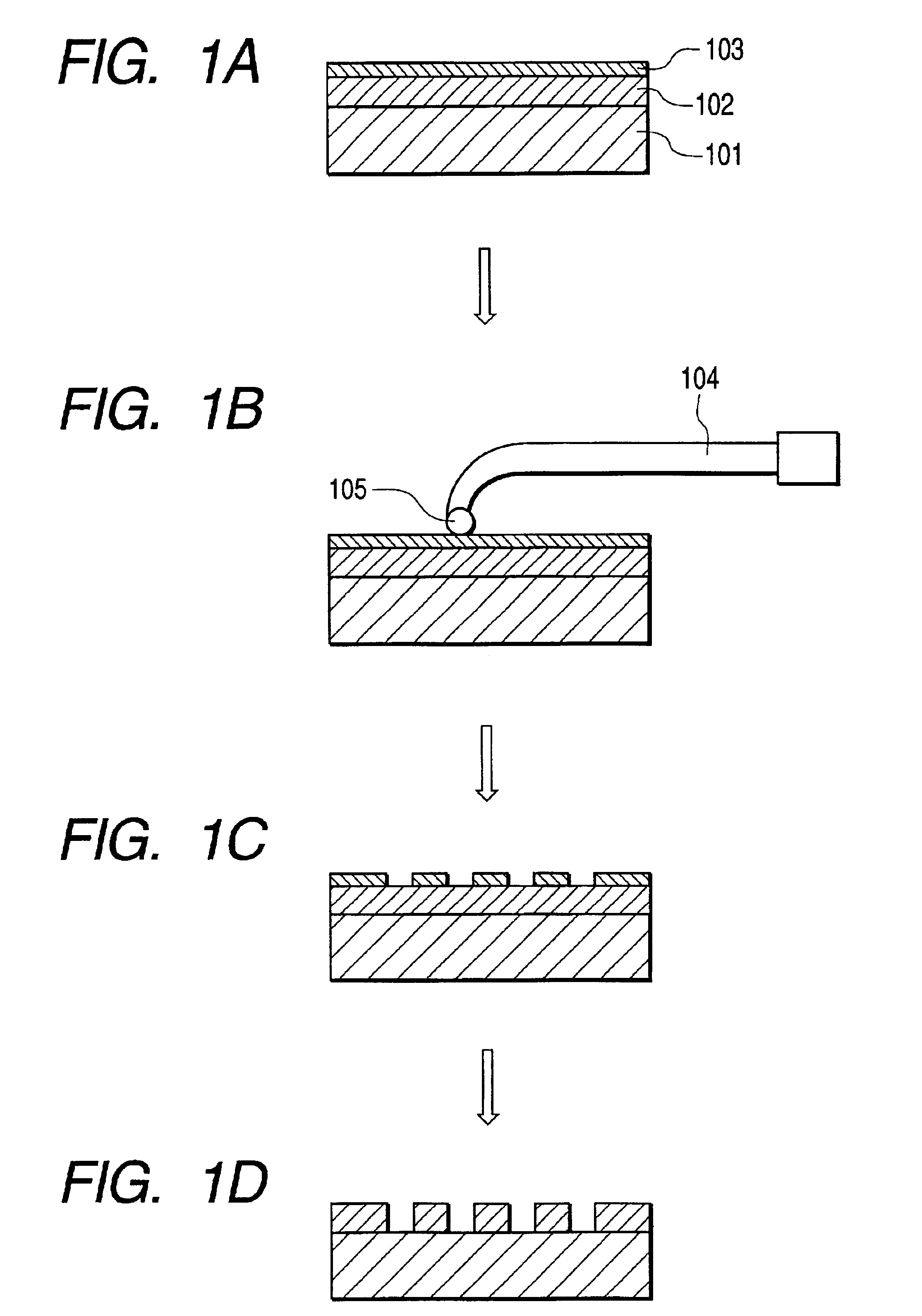Photoresist, photolithography method using the same, and method for producing photoresist
a photolithography and photoresist technology, applied in the field of photoresist, can solve the problems of shortening the laser wavelength, miniaturizing equipment, and the thickness of the photoresist film cannot be as thick as those in the conventional methods, and achieves the effects of reducing pattern edge roughness, improving pattern rectangularity, and high light utilization efficiency
- Summary
- Abstract
- Description
- Claims
- Application Information
AI Technical Summary
Benefits of technology
Problems solved by technology
Method used
Image
Examples
example 1
The diazide compound containing a photosensitive compound 1,2-naphthoquinone diazide-5-sulfonic acid ester as the main component in an amount corresponding to 80 parts by weight per 100 parts by weight of a photoresist base resin (alkali-soluble novolak resin) and PGMEA as solvent were added to a commercial positive photoresist for semiconductor production containing 30 parts by weight of a photosensitive compound (naphthoquinone diazide) per 100 parts by weight of the photoresist base resin, and the resultant was mixed to prepare a positive photoresist for near-field exposure having a viscosity of 5 cP. The absorption coefficient of the photoresist was measured and found to be 1.0.
A substrate was spin-coated with the positive photoresist for near-field exposure in a sealed space to form a photoresist layer for image formation.
A glass substrate 101 having a deposited Cr layer 102 of 30 nm in thickness was used as the substrate (see FIG. 1A). Then the Cr layer was spin-coated with th...
example 2
The diazide compound containing a photosensitive compound 1,2-naphthoquinone diazide-5-sulfonic acid ester as the main component in an amount corresponding to 80 parts by weight per 100 parts by weight of the alkali-soluble novolak resin as a base resin (molecular weight distribution (Mw / Mn) is 2.5) was added to a photoresist containing 30 parts by weight of a photosensitive compound (naphthoquinone diazide) per 100 parts by weight of the base resin, and further GPMEA as solvent was added thereto, and the resultant was mixed to prepare a positive photoresist for near-field exposure having a viscosity of 5 cP. The absorption coefficient of the photoresist was measured and found to be 1.0.
A substrate was spin-coated with the positive photoresist for near-field exposure under the spin-coating condition 7,000 rpm×60 sec in a sealed space to form a photoresist layer for image formation. An SOI (Silicon On Insulator) substrate 201 having an upper Si layer 202 of 50 nm in thickness was use...
example 3
The diazide compound containing a photosensitive compound 1,2-naphthoquinone diazide-5-sulfonic acid ester as the main component in an amount corresponding to 80 parts by weight per 100 parts by weight of a base resin (alkali-soluble novolak resin) was added to a commercial Si-containing photoresist for semiconductor production including 15 parts by weight of a photosensitive compound (naphthoquinone diazide) per 100 parts by weight of the base resin and further GPMEA as solvent was added thereto, and the resultant was mixed to prepare a positive photoresist for near-field exposure having a viscosity of 5 cP. The absorption coefficient of the photoresist was measured and found to be 1.0.
An SOI (Silicon On Insulator) substrate 303 having an upper Si layer of 300 nm in thickness was used as the substrate. In order to apply the multilayer photoresist method, a commercial positive photoresist was applied to the upper Si layer by using a spin coater, and then the substrate was hard-baked...
PUM
 Login to View More
Login to View More Abstract
Description
Claims
Application Information
 Login to View More
Login to View More - R&D
- Intellectual Property
- Life Sciences
- Materials
- Tech Scout
- Unparalleled Data Quality
- Higher Quality Content
- 60% Fewer Hallucinations
Browse by: Latest US Patents, China's latest patents, Technical Efficacy Thesaurus, Application Domain, Technology Topic, Popular Technical Reports.
© 2025 PatSnap. All rights reserved.Legal|Privacy policy|Modern Slavery Act Transparency Statement|Sitemap|About US| Contact US: help@patsnap.com



